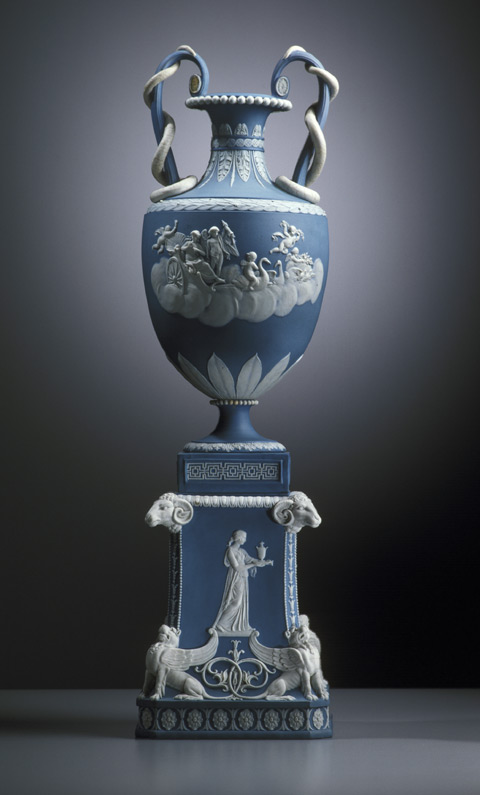Description
This is a solid blue-and-white jasper (stoneware) vase made by Josiah Wedgwood and Sons, England, between 1784 and 1790. Measuring 62.0 cm (height) x 17.5 cm (width) x 17.5 cm (depth), the vase is a classically urn-shaped form set on a tall rectangular pedestal. The vase has a shield-shaped body with a flared foot resting on a square base, and a waisted neck with flaring lip. Two handles, each depicting a white snake entwined around a blue loop form, connect the shoulders of the vase to its lip. Around the neck, foot and base of the vase, and around the rectangular pedestal are bands of classical motifs. An extensive relief panel in white jasper depicting the goddess Venus surrounded by 'putti' (young children with wings) and being drawn in a chariot by swans, one bearing a winged child, can be seen on the facing side of the vase. A classically draped woman holding a vase in the shape of a cornucopia (horn of plenty) is set in the middle of the facing panel of the pedestal. Four rams' heads and four mythological creatures with the bodies and heads of a lion and the wings of a large bird are attached to each corner of the pedestal.
Educational value
- The vase is closely associated with Josiah Wedgwood (1730-95), widely regarded as the most important English potter of his century, who was largely responsible for introducing the use of ceramics (earthenware and stoneware) as fashionable tableware and ornaments of choice - wealthier English households in the 18th century had preferred to use porcelain, which was considered the most sophisticated type of ceramics until the 1770s.
- Wedgwood's reputation and commercial success were founded primarily on the fashionable appeal of his wares, and he constantly experimented technically and stylistically with his products, inventing a whole range of glazes and ceramic materials, such as jasper, and using an impressive range of marketing methods, some of which he developed himself - in 1783, Wedgwood was awarded the significant honour of membership of the Royal Society for his invention of the pyrometer, a device for measuring the temperature of pottery kilns, which is still in use today.
- The design of the vase shows how classical art was adapted to design of the period, with most of the forms and decorative scenes used on Wedgwood's ceramics derived from Greek and Roman art, in particular antique pottery and gems.
- The most sophisticated ornaments applied to Wedgwood vases and panels were designed by leading artists of the day, and some, such as those on this vase, were based on classically inspired paintings - the two white jasper scenes in relief on this vase were inspired by the work of baroque painter Charles Le Brun (1619-90) and were applied on opposite sides of the body: one depicts 'Venus in her chariot drawn by swans', while the other (not visible) shows 'Cupid watering the swans'; Venus, the Roman goddess of spring (also identified with the Greek goddess Aphrodite, the goddess of love and fertility), was the subject of many of the decorative reliefs applied to Wedgwood's vases and decorative ceramic panels.
- Always ahead of rivals in his stylistic and technological innovations, Wedgwood developed a range of new ceramic materials for 'ornamental ware', the most important of which was jasper, a fine-grained, hard, pure white stoneware, introduced in 1774 and named jasper because of its resemblance to ancient hardstone gems - this versatile material was often stained, through the body or on the surface only, in a range of colours, the most famous being 'Wedgwood blue', now a registered trademark of the Wedgwood Group.
- The white jasper reliefs were made by casting white clay slip (liquid clay) in reverse moulds and when these individual castings had dried to a leathery hardness, they were carefully attached, using slip as the bonding agent, to the surface of the vase and its base, with the complete vase then fired at a high temperature to achieve the finished product.
- This vase is an example of Wedgwood's response to the renewed fascination, from about 1760, of the English aristocracy, intellectuals and affluent middle classes with antiquity, a fascination leading to a new style known as Neoclassicism which was inspired by 'grand tours' to Greece and Rome, excavations of ancient cities, especially Pompeii and Herculaneum, and publications on ancient art - Wedgwood copied or adopted designs for his vases from a wide variety of sources, ranging from original antique vases in the collections of friends and patrons to publications; in particular, Wedgwood made extensive use of 'Antiquités étrusques, grecques, et romaines', a four-volume work of 1766-76 compiled by D'Hancarville and devoted to the fabulous collection of Greek and Italian vases of Sir William Hamilton.
- Developed in Britain and France in the 1750s, Neoclassicism was well established across Europe by the 1770s - replacing playful rococo designs with the values of ancient Greece and Rome, the 'antique manner' flourished in all visual arts and architecture into the early years of the 19th century; neoclassical designs were guided by the ancient ideals of symmetry, balance and proportion, and used figures from Greek mythology as well as Greek motifs such as cameo medallions or the Greek key found on ancient gems and vases.
